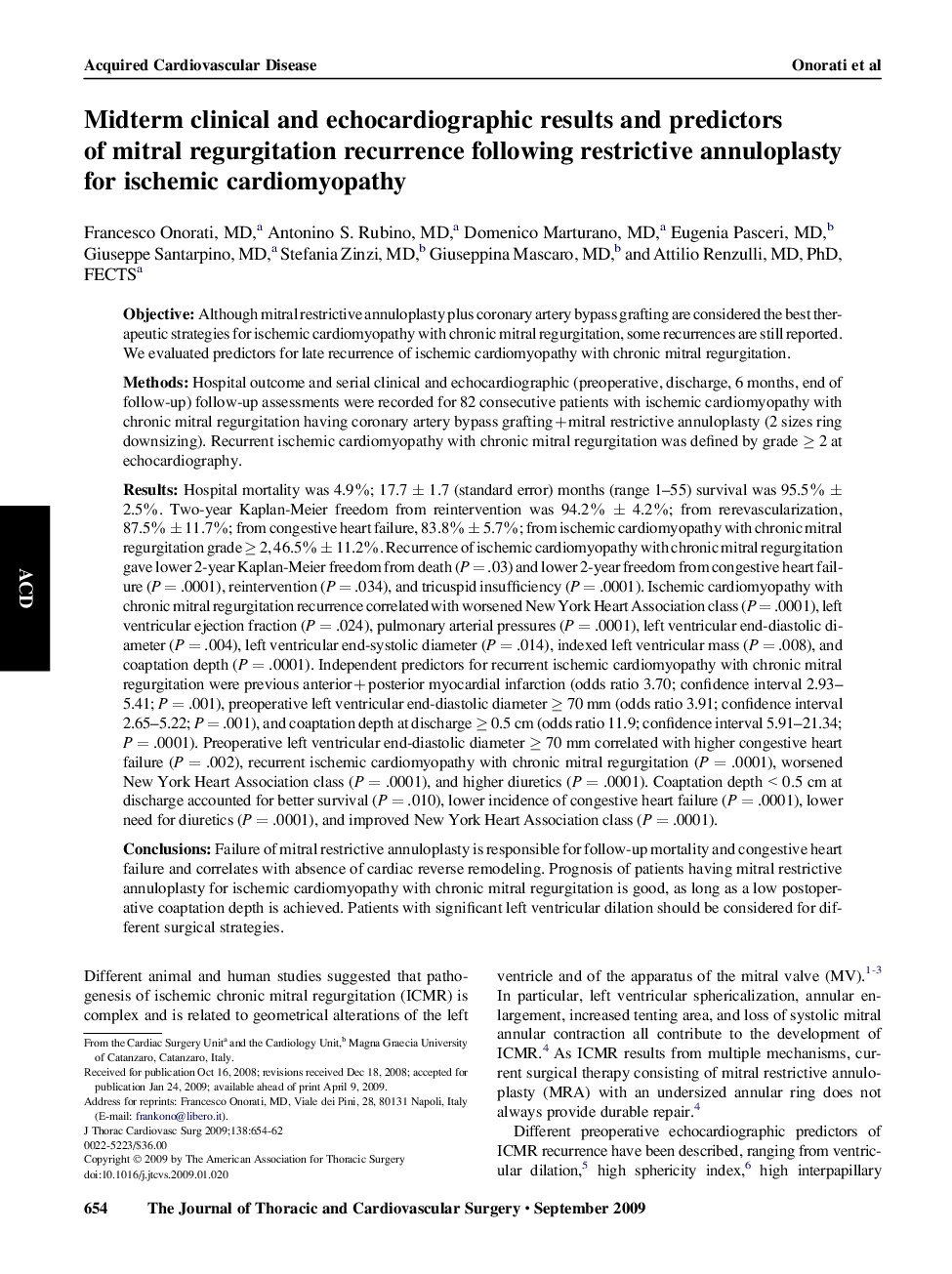| کد مقاله | کد نشریه | سال انتشار | مقاله انگلیسی | نسخه تمام متن |
|---|---|---|---|---|
| 2985568 | 1578670 | 2009 | 9 صفحه PDF | دانلود رایگان |

ObjectiveAlthough mitral restrictive annuloplasty plus coronary artery bypass grafting are considered the best therapeutic strategies for ischemic cardiomyopathy with chronic mitral regurgitation, some recurrences are still reported. We evaluated predictors for late recurrence of ischemic cardiomyopathy with chronic mitral regurgitation.MethodsHospital outcome and serial clinical and echocardiographic (preoperative, discharge, 6 months, end of follow-up) follow-up assessments were recorded for 82 consecutive patients with ischemic cardiomyopathy with chronic mitral regurgitation having coronary artery bypass grafting + mitral restrictive annuloplasty (2 sizes ring downsizing). Recurrent ischemic cardiomyopathy with chronic mitral regurgitation was defined by grade ≥ 2 at echocardiography.ResultsHospital mortality was 4.9%; 17.7 ± 1.7 (standard error) months (range 1–55) survival was 95.5% ± 2.5%. Two-year Kaplan-Meier freedom from reintervention was 94.2% ± 4.2%; from rerevascularization, 87.5% ± 11.7%; from congestive heart failure, 83.8% ± 5.7%; from ischemic cardiomyopathy with chronic mitral regurgitation grade ≥ 2, 46.5% ± 11.2%. Recurrence of ischemic cardiomyopathy with chronic mitral regurgitation gave lower 2-year Kaplan-Meier freedom from death (P = .03) and lower 2-year freedom from congestive heart failure (P = .0001), reintervention (P = .034), and tricuspid insufficiency (P = .0001). Ischemic cardiomyopathy with chronic mitral regurgitation recurrence correlated with worsened New York Heart Association class (P = .0001), left ventricular ejection fraction (P = .024), pulmonary arterial pressures (P = .0001), left ventricular end-diastolic diameter (P = .004), left ventricular end-systolic diameter (P = .014), indexed left ventricular mass (P = .008), and coaptation depth (P = .0001). Independent predictors for recurrent ischemic cardiomyopathy with chronic mitral regurgitation were previous anterior + posterior myocardial infarction (odds ratio 3.70; confidence interval 2.93–5.41; P = .001), preoperative left ventricular end-diastolic diameter ≥ 70 mm (odds ratio 3.91; confidence interval 2.65–5.22; P = .001), and coaptation depth at discharge ≥ 0.5 cm (odds ratio 11.9; confidence interval 5.91–21.34; P = .0001). Preoperative left ventricular end-diastolic diameter ≥ 70 mm correlated with higher congestive heart failure (P = .002), recurrent ischemic cardiomyopathy with chronic mitral regurgitation (P = .0001), worsened New York Heart Association class (P = .0001), and higher diuretics (P = .0001). Coaptation depth < 0.5 cm at discharge accounted for better survival (P = .010), lower incidence of congestive heart failure (P = .0001), lower need for diuretics (P = .0001), and improved New York Heart Association class (P = .0001).ConclusionsFailure of mitral restrictive annuloplasty is responsible for follow-up mortality and congestive heart failure and correlates with absence of cardiac reverse remodeling. Prognosis of patients having mitral restrictive annuloplasty for ischemic cardiomyopathy with chronic mitral regurgitation is good, as long as a low postoperative coaptation depth is achieved. Patients with significant left ventricular dilation should be considered for different surgical strategies.
Journal: The Journal of Thoracic and Cardiovascular Surgery - Volume 138, Issue 3, September 2009, Pages 654–662